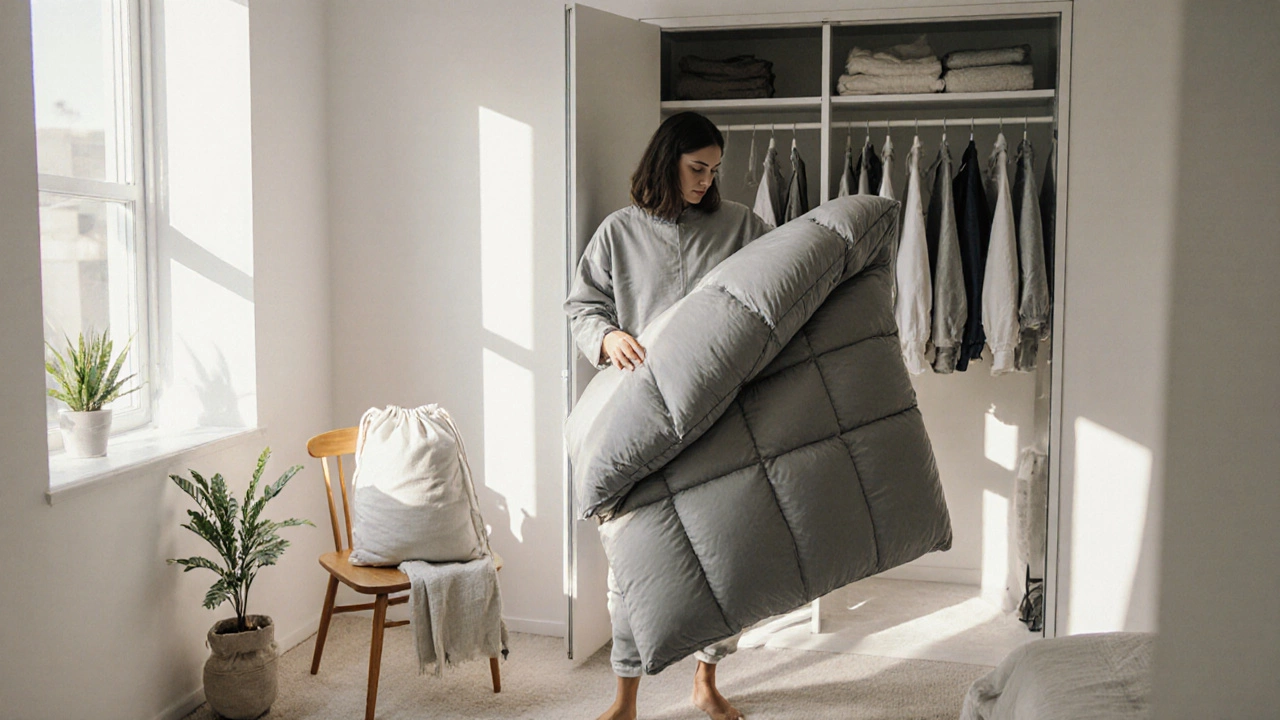When to Replace a Comforter: Key Signs It’s Time to Toss Your Bedding
 Oct, 22 2025
Oct, 22 2025
Ever wondered why your comforter feels less cozy after a few years? You’re not alone. Knowing when a comforter has outlived its usefulness can save you from sleepless nights, allergies, and wasted money.
Comforter is a thick, quilted blanket filled with down, synthetic fibers, or a blend, designed to keep you warm while you sleep. It typically features a stitched pattern that holds the fill in place and a decorative outer fabric. Over time, that fill can shift, the fabric can wear, and the whole piece can become a breeding ground for dust mites. Below we’ll walk through the exact moments you should consider tossing it out.
Why Comforters Don’t Last Forever
All textiles degrade, but a comforter faces extra stress: frequent washes, body oils, and constant contact with your skin. Understanding the main culprits helps you spot trouble early.
- Fill breakdown: Down clusters separate, synthetic fibers clump, and cotton batting loses loft.
- Fabric wear: Seams split, the outer cover fades, and pilling appears.
- Microbial growth: Dust mites, mold, and bacteria thrive in warm, humid environments.
Visual and Tactile Red Flags
Give your comforter a quick once‑over before each seasonal change. If you notice any of these, it’s time to think about replacement:
- Visible holes or tears in the stitching or fabric.
- Thinning fill that leaves cold spots.
- Persistent odors that won’t disappear after washing.
- Excessive pilling on the surface, which reduces softness.
- Discoloration or fading that looks uneven.
Health‑Related Triggers
Allergies don’t wait for a convenient moment. If you or a family member starts sneezing, coughing, or experiencing skin irritation at night, your comforter could be the culprit.
Key health indicators include:
- Dust mites are tiny arachnids that love the warm, moist layers of a comforter. Their waste proteins can trigger asthma and allergic rhinitis.
- Recurring mold spots, especially in humid climates.
- Increased skin allergies that flare up after bedding contact.
How Long Should a Comforter Last?
The lifespan varies by material, care routine, and usage frequency. Here’s a quick guide:
| Fill Type | Average Lifespan | Best Care Method |
|---|---|---|
| Down (European or Goose) | 7-10 years | Professional cleaning + occasional air‑out |
| Synthetic (Polyester) | 5-7 years | Machine wash on gentle cycle, tumble dry low |
| Cotton batting | 4-6 years | Machine wash, avoid high heat |
If your comforter is approaching these age ranges, start budgeting for a replacement, even if it looks okay.

Factors That Accelerate Wear
Not all comforters age at the same speed. Keep an eye on these drivers:
- Frequency of washes: More than three washes per year can degrade fill quickly.
- Climate: Humid areas encourage mildew and dust‑mite growth.
- Pets: Fur and claws can puncture the fabric and deposit allergens.
- Usage pattern: Using the same comforter year‑round reduces its lifespan.
Cleaning Tips to Extend Life
Good care won’t make a worn‑out comforter last forever, but it can shave several months off the clock.
- Check the care label for wash cycle recommendations. Most synthetic fills tolerate a gentle machine wash; down usually needs professional cleaning.
- Use a mild, low‑pH detergent. Avoid fabric softeners-they coat the fill and reduce loft.
- Dry on low heat with clean tennis balls or dryer balls to break up clumps.
- Air‑out the comforter in sunlight once a month; UV rays help kill microbes.
- Store in a breathable cotton bag during off‑season storage, not in plastic.
Cost‑Benefit Cheat Sheet
When your comforter starts to act up, weigh these numbers:
- Average price of a quality down comforter: $150‑$300.
- Cleaning cost: $30‑$60 per professional clean.
- Energy cost for a full‑size dryer cycle: roughly $0.30 per use.
If you’re spending more on cleaning than you’d pay for a new one, it’s a clear sign to replace.

Quick Decision Checklist
Use this printable list to decide if it’s time for a new comforter:
- Are there any holes, tears, or significant pilling? ✅
- Do you notice cold spots or uneven warmth? ✅
- Is the smell persistent after a wash? ✅
- Have you experienced new nighttime allergies? ✅
- Is the comforter older than the average lifespan for its fill? ✅
If you checked “yes” on three or more items, start shopping for a replacement.
Choosing the Right Replacement
Now that you know it’s time, picking the next comforter is easier if you match it to your lifestyle.
- Allergy‑prone households: Opt for hypoallergenic synthetic fills that resist dust mites.
- Cold climates: Go for high‑loft down or a down‑alternative with a high fill power.
- Eco‑conscious buyers: Look for responsibly sourced down (e.g., RDS‑certified) or recycled polyester fill.
- Frequent washers: Choose a comforter labeled machine‑washable.
Final Thoughts
Keeping a comforter beyond its prime isn’t just a comfort issue; it can affect health, sleep quality, and your wallet. By checking for visual wear, monitoring allergies, and understanding the typical lifespan of each fill type, you’ll know exactly when to say goodbye and welcome a fresh, cozy night’s sleep.
How often should I wash my comforter?
Most experts recommend washing a comforter once or twice a year. If you have allergies or pets, consider a quarterly wash using the care‑label instructions.
Can I dry‑clean a down comforter?
Yes, professional dry cleaning is safe for most down comforters and often recommended to preserve loft and prevent clumping.
What’s the difference between down and synthetic fills?
Down offers superior warmth‑to‑weight ratio and longevity but can trigger allergies. Synthetic fills are hypoallergenic, easier to wash, and often cheaper.
How can I tell if my comforter has dust mites?
A common sign is nighttime sneezing or itchy eyes that improve when you sleep without the comforter. You can also do a simple allergen test kit or send a small sample to a lab.
Is it better to store a comforter in a plastic bag?
No. Plastic traps moisture, encouraging mold and mites. Use a breathable cotton storage bag and keep it in a cool, dry closet.